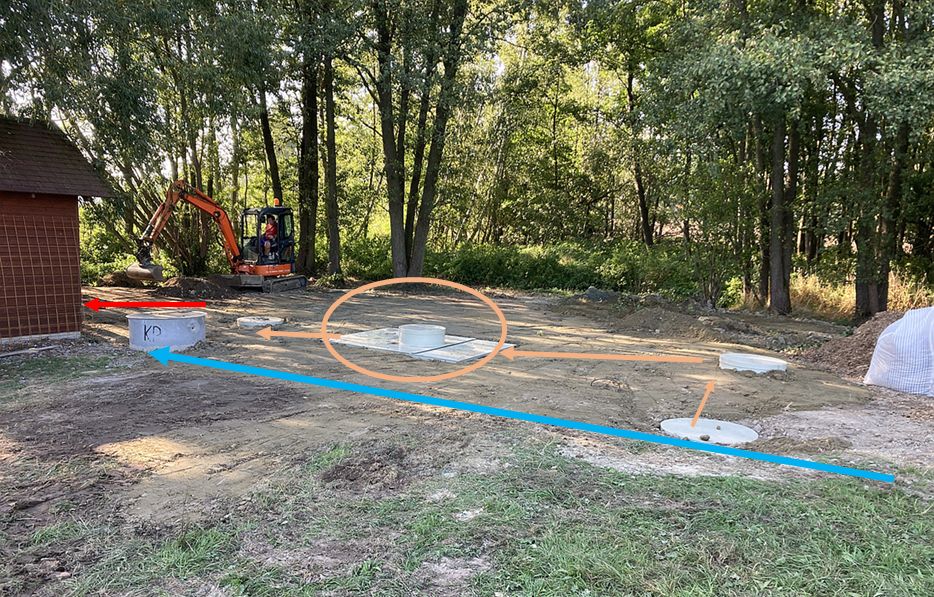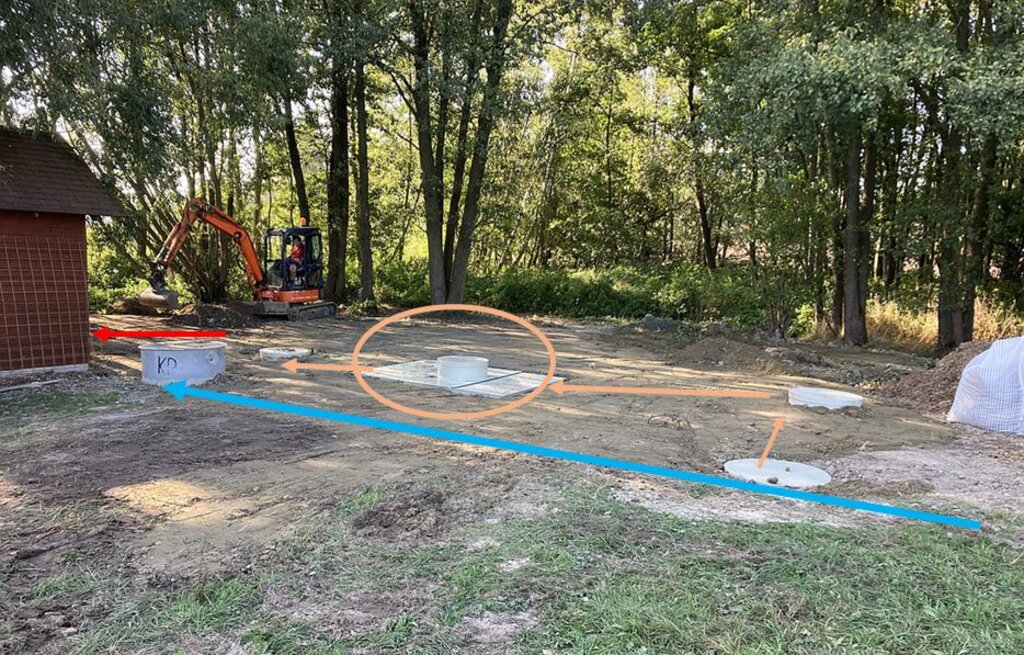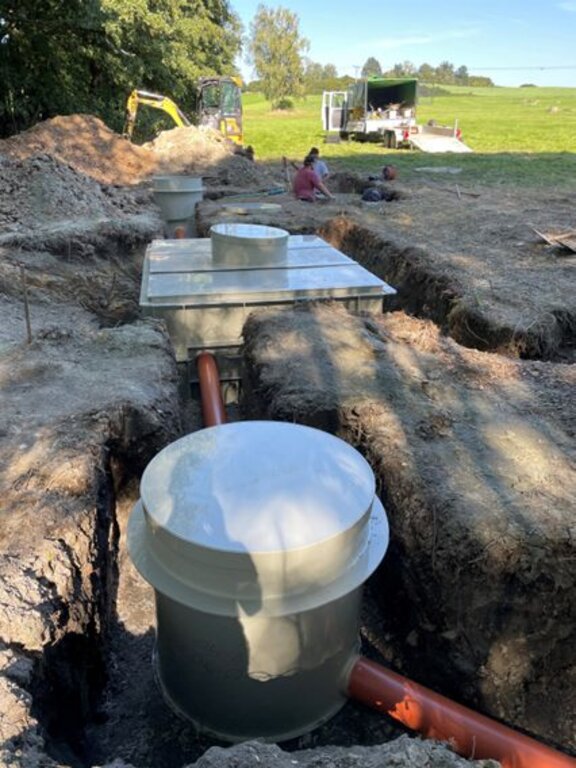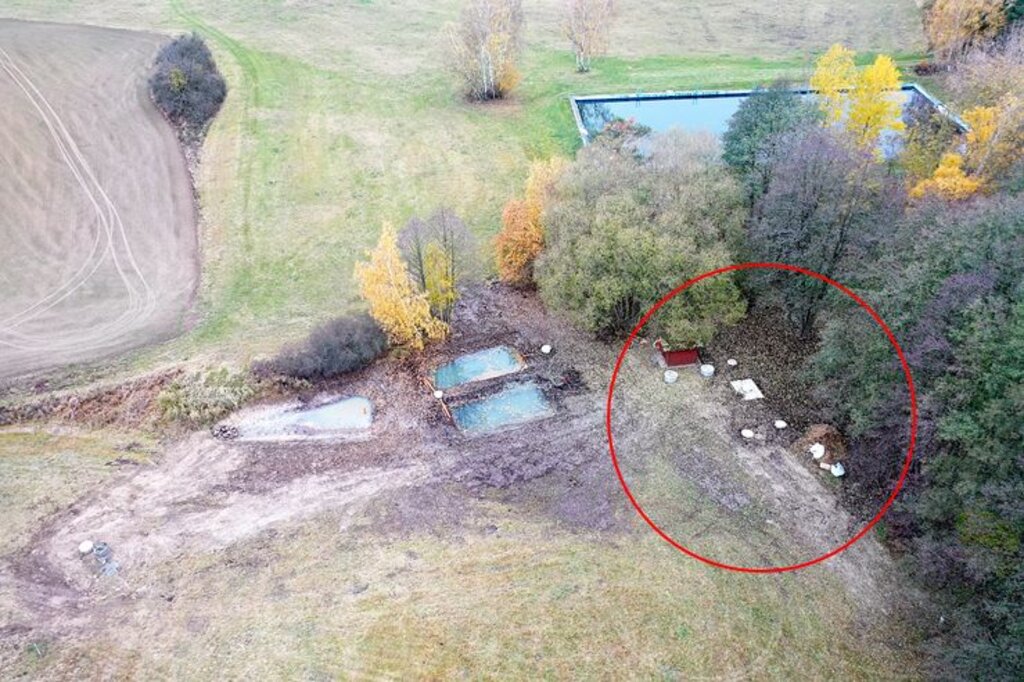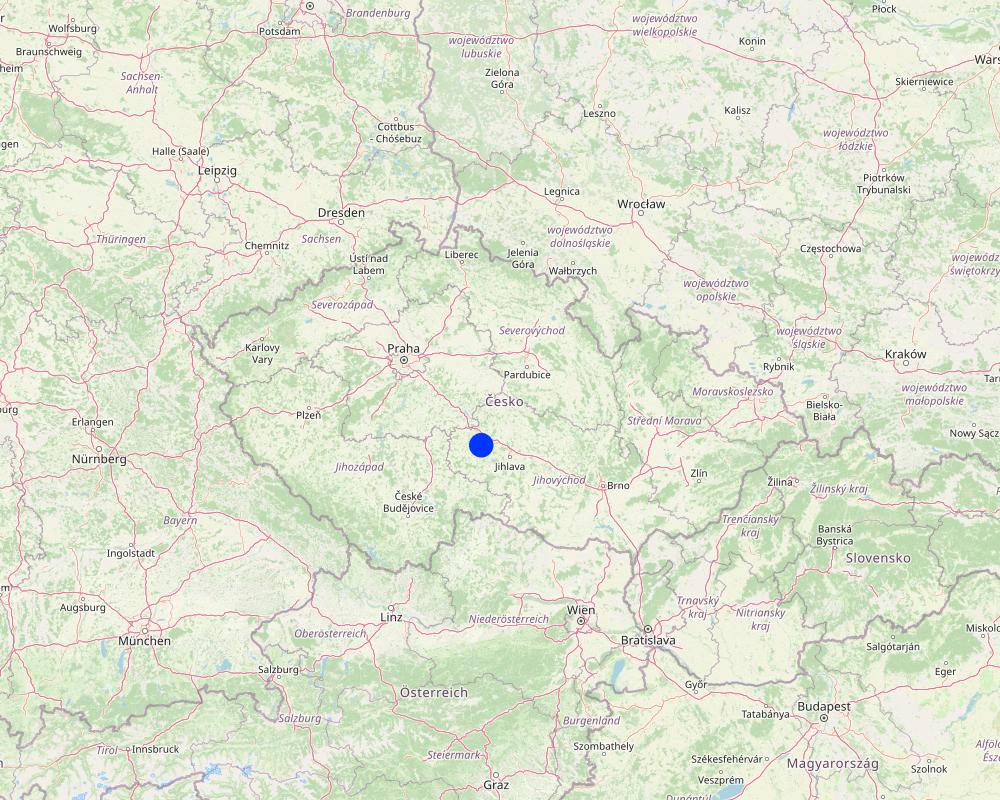Drainage Biofilter [República Tcheca]
- Criação:
- Atualização:
- Compilador/a: Antonín Zajíček
- Editor: –
- Revisores: William Critchley, Rima Mekdaschi Studer
Drenážní biofiltr
technologies_6259 - República Tcheca
Veja as seções
Expandir tudo Recolher tudo1. Informação geral
1.2 Detalhes do contato das pessoas capacitadas e instituições envolvidas na avaliação e documentação da tecnologia
Nome do projeto que facilitou a documentação/avaliação da Tecnologia (se relevante)
OPtimal strategies to retAIN and re-use water and nutrients in small agricultural catchments across different soil-climatic regions in Europe (OPTAIN)Nome do projeto que facilitou a documentação/avaliação da Tecnologia (se relevante)
Approaches for design and realization of complex effective measures for tile drained agricultural catchments by land consolidations (QK21010341)Nome da(s) instituição(ões) que facilitou(ram) a documentação/ avaliação da Tecnologia (se relevante)
Research Institute for Soil and Water Conservation (VUMOP) - República Tcheca1.3 Condições em relação ao uso da informação documentada através de WOCAT
O compilador e a(s) pessoa(s) capacitada(s) aceitam as condições relativas ao uso de dados documentados através do WOCAT:
Sim
1.4 Declaração de sustentabilidade da tecnologia descrita
A tecnologia descrita aqui é problemática em relação a degradação da terra de forma que não pode ser declarada uma tecnologia de gestão sustentável de terra?
Não
Comentários:
The advantage of the drainage biofilter is that it occupies only a relatively small area and only minimally impedes soil cultivation
1.5 Referência ao(s) questionário(s) sobre abordagens GST (documentado(s) usando WOCAT)
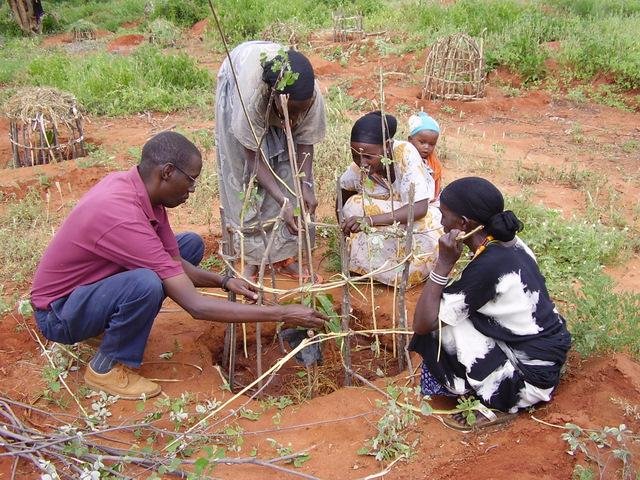
Catchment Approach [Quênia]
A focused approach to integrated land and water management, including soil and water conservation, where the active participation of the villagers - often organised through common interest groups - is central.
- Compilador/a: James Gatero Njuki
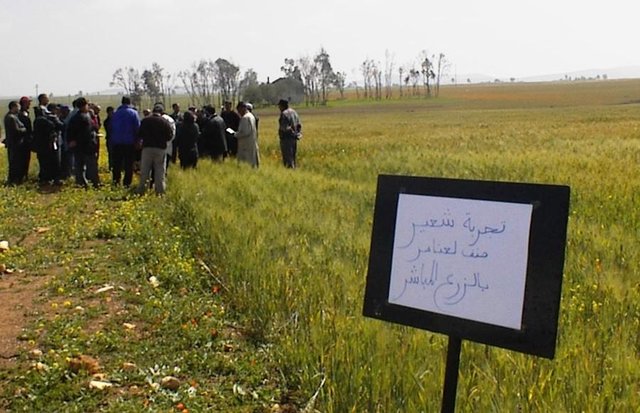
Applied research and knowledge transfer [Marrocos]
Innovative, cross-disciplinary community-based approach for development and transfer of no-till technology at the farm level.
- Compilador/a: Rachid Mrabet
2. Descrição da tecnologia de GST
2.1 Descrição curta da tecnologia
Definição da tecnologia:
Biofilters or “bioreactors” connected to agricultural tile drains are relatively inexpensive and space-saving measures with considerable potential to improve the quality of drainage water.
2.2 Descrição detalhada da tecnologia
Descrição:
A biofilter or “bioreactor” is a relatively small installation used to break down pollutants from drainage water. Its basic function is to allow the passage of drainage water, contaminated with nutrients and pesticides, through a container with pollutant-reducing agents. Bioreactors are usually located at the bottom of agricultural drainage structures on the drains or in connection with drainage outlets. Ideally, the biofilter is located on a site that is no longer part of the cultivated land or is under permanent grassland.
In principle, two biofilter solutions are possible. In the case of low and regular drainage flows, the drainage section is directly replaced by a biofilter. With higher flows and in the case of rapid response of the drainage structure to rainfall-runoff episodes, the biofilter is placed parallel to the outlet drain or is located under the drainage outlet (if ambient conditions allow). Such a design includes a distribution structure (preferably located in a drainage manhole) and a drainage pipe to allow safe bypassing of a portion of the elevated drainage outlet, to maintain the residence time of the water in the biofilter and thus its corresponding efficiency.
The biofilter may be designed as closed or open. A closed biofilter is completely buried and normal tillage can take place. An open biofilter lacks the advantage of an undisturbed terrain but has the advantage of benefitting from plants that enhance the purification of drainage water by bacteria living on their roots.
The installation always consists of a bed or container in which the reducing agent is enclosed, ensuring the isolation of the agent from the surrounding soil and water. In the case of a smaller sized closed biofilter, a plastic container can be used, while in the case of a larger or open design, plastic film can be used as a bed. Various materials can be used as biofilter fillings, or substrates, both individually and in combination. In most cases, the reducing agent is carbonaceous, with denitrification mediated by chemo-organotrophic bacteria.
In terms of N-NO3 removal, the most effective are wood chips, which have a high hydraulic conductivity and a C:N ratio of 30:1 to 300:1. In particular, chips from poplar, pine and larch are suitable. For the removal of pesticides or biopharmaceuticals, then biochar (biochar) and lignite are suitable as natural and readily available materials. A combination of materials can also be used. For example, the addition of biochar to the wood chips will increase the efficiency of the bioreactor in degrading pesticides, or the charge can be combined with an inorganic substrate (sand, vermiculite), which is added to prevent undesirable settling, reduce hydraulic conductivity and at the same time mechanically purify the drainage water.
2.3 Fotos da tecnologia
2.5 País/região/locais onde a tecnologia foi aplicada e que estão cobertos nesta avaliação
País:
República Tcheca
Região/Estado/Província:
Vysočina region (Highlands Region)
Especificação adicional de localização:
Černičí, Dehtáře
Especifique a difusão da tecnologia:
- Aplicado em pontos específicos/concentrado numa pequena área
O(s) local(is) tecnológico(s) está(ão) localizado(s) em uma área permanentemente protegida?
Não
Map
×2.6 Data da implementação
Caso o ano exato seja desconhecido, indique a data aproximada:
- menos de 10 anos atrás (recentemente)
2.7 Introdução da tecnologia
Especifique como a tecnologia foi introduzida:
- durante experiências/ pesquisa
- através de projetos/intervenções externas
Comentários (tipos de projeto, etc.):
Several biofilters have already been implemented as part of research projects, and the development of a standardized, efficient and easy-to-implement solution is currently underway.
3. Classificação da tecnologia de GST
3.1 Principal/principais finalidade(s) da tecnologia
- Protege uma bacia/zonas a jusante – em combinação com outra tecnologia
- Preservar/melhorar a biodiversidade
- reduce diffusive agricultural pollution
3.2 Tipo(s) atualizado(s) de uso da terra onde a tecnologia foi aplicada
Uso do solo misturado dentro da mesma unidade de terra:
Não

Terra de cultivo
- Cultura perene (não lenhosa)
Cultivo perene (sem lã) - Especificar culturas:
- culturas forrageiras - gramíneas
Número de estações de cultivo por ano:
- 1
O cultivo entre culturas é praticado?
Não
O rodízio de culturas é praticado?
Não

Vias navegáveis, corpo d'água, zonas úmidas
- Linhas de drenagem, vias navegáveis
3.3 O uso do solo mudou devido à implementação da Tecnologia?
O uso do solo mudou devido à implementação da Tecnologia?
- Sim (Por favor, preencha as perguntas abaixo com relação ao uso do solo antes da implementação da Tecnologia)

Terra de cultivo
- Cultura anual
Cultivo anual - Especificar culturas:
- cereais - cevada
- cereais - milho
- cereais - trigo (inverno)
- culturas oleaginosas - girassol, colza, outros
- culturas de raiz/tubérculos- batatas
O cultivo entre culturas é praticado?
Sim
Em caso afirmativo, especifique quais são as culturas intercultivadas:
In some seasons, spring cereal mix, legume-cereal mix or undersown clover is used as an intercrop
O rodízio de culturas é praticado?
Sim
Caso afirmativo, especifique:
five-years or seven-years crop rotation containinng winter cereals, spring cereals, potatoes, red clover, oil seed rape and maize
3.4 Abastecimento de água
Abastecimento de água para a terra na qual a tecnologia é aplicada:
- Precipitação natural
3.5 Grupo de GST ao qual pertence a tecnologia
- Gestão de água de superfície (nascente, rio, lagos, mar)
- Gestão do lençol freático
3.6 Medidas de GST contendo a tecnologia

Medidas vegetativas
- V2: gramíneas e plantas herbáceas perenes

Medidas estruturais
- S11: Outros
3.7 Principais tipos de degradação da terra abordados pela tecnologia

Degradação da água
- Hp: declínio da qualidade de água de superfície
- Hq: declínio da qualidade do lençol freático
3.8 Redução, prevenção ou recuperação da degradação do solo
Especifique o objetivo da tecnologia em relação a degradação da terra:
- Não aplicável
Comentários:
This measure is primarily aimed at improving water quality.
4. Especificações técnicas, implementação de atividades, entradas e custos
4.1 Desenho técnico da tecnologia
Especificações técnicas (relacionada ao desenho técnico):
The drawing shows a closed biofilter/bioreactor system, which is built as a bypass of the existing drainage pipe. The measure is looped at the bottom of the drainage system to approximate the recipient.
This system consists mainly of the following features:
1) Drainage water inlet - existing drainage pipe - tile drains
2) Flow control facillity, which is built on top of the existing drainage pipe. The main line structure was excavated, the original ceramic pipe was replaced with a plastic PP pipe and a manhole with an embedded baffle was inserted to allow the water to rise to the required level and subsequently overflow the excess water over the overflow edge. A control element is placed in the manhole to regulate the flow of water into the system.
3) The existing drain, which, once the measures are constructed, serves as a bypass for excess runoff during spring thaw or significant rainfall-runoff episodes.
4) Inflow to the biofilter in the form of a newly constructed pipe.
5) Bed of biofilter - a hardened bed to prevent destruction of the biofilter by shallow groundwater levels and a plastic container for the actual biofilter fill.
6) Biofilter fill. I.n this case a mixture of vermiculite, wood chips and biochar, alternatively wood chips themselves or other materials can be used
7) Purified water outlet from the biofilter
8) Flow control facility, built in drainage manhole, purified water is returned to the existing drainage pipe
9) Drainage outlet
Autor:
Research Institute for Soil and Water Conservation
Data:
01/02/2023
4.2 Informação geral em relação ao cálculo de entradas e custos
Especifique como custos e entradas foram calculados:
- Por unidade de tecnologia
Especifique a unidade:
measure - one system of closed biofilter/bioreactor
Outro/moeda nacional (especifique):
EUR
Se for relevante, indique a taxa de câmbio do USD para moeda local (por exemplo, 1 USD = 79,9 Real): 1 USD =:
0,92
Indique a média salarial da mão-de-obra contratada por dia:
150
4.3 Atividades de implantação
| Atividade | Periodicidade (estação do ano) | |
|---|---|---|
| 1. | Selecting proper place for the measure | Before implementation |
| 2. | Obtaining the consent of the owners and users of the affected land | Before implementation |
| 3. | Project documentation | Before implementation |
| 4. | Water management office permisiond and building permission | Before implementation |
| 5. | Excavation works | Drier period, ideally at the end of the growing season |
| 6. | Biofilter construction | Drier period, ideally at the end of the growing season |
| 7. | Filling the biofilter with substrates | Drier period, ideally at the end of the growing season |
4.4 Custos e entradas necessárias para a implantação
| Especifique a entrada | Unidade | Quantidade | Custos por unidade | Custos totais por entrada | % dos custos arcados pelos usuários da terra | |
|---|---|---|---|---|---|---|
| Mão-de-obra | Project/design | person-days | 5,0 | 200,0 | 1000,0 | 100,0 |
| Mão-de-obra | Engineering | person-days | 10,0 | 200,0 | 2000,0 | 100,0 |
| Mão-de-obra | Implementation of the measure | person-days | 6,0 | 150,0 | 900,0 | 100,0 |
| Equipamento | Tansport of material | machine-days | 5,0 | 150,0 | 750,0 | 100,0 |
| Equipamento | Excavation works | machine-days | 3,0 | 220,0 | 660,0 | 100,0 |
| Material vegetal | grasss seeding | kg | 10,0 | 8,0 | 80,0 | 100,0 |
| Material de construção | Distribution object (manhole) | piece | 2,0 | 2200,0 | 4400,0 | 100,0 |
| Material de construção | Container for filling the biofilter | piece | 1,0 | 2400,0 | 2400,0 | 100,0 |
| Material de construção | Sorbents (vermukulit, biochar, woodchips) | m3 | 3,0 | 440,0 | 1320,0 | 100,0 |
| Material de construção | drainage pipes and other material | m | 20,0 | 2,0 | 40,0 | 100,0 |
| Custos totais para a implantação da tecnologia | 13550,0 | |||||
| Custos totais para o estabelecimento da Tecnologia em USD | 14728,26 | |||||
Se o usuário da terra arca com menos que 100% dos custos, indique quem cobre os custos remanescentes:
co-financing from public sources
Comentários:
Under certain conditions, owners and users of land, regardless of their legal form, municipalities and other public entities may apply for a subsidy for the implementation of this measure, which is provided by the Ministry of the Environment of the Czech Republic
The subsidy is up to 100 % of the total eligible expenditure, the minimum eligible direct implementation expenditure per project is set at CZK 250 000 ( 10 000 EUR), excluding VAT.
4.5 Atividades recorrentes/manutenção
| Atividade | Periodicidade/frequência | |
|---|---|---|
| 1. | Exchange of reducing agent in biofilter | every 5 - 10 years |
| 2. | Cutting the grass aroun the measure | twice a year |
| 3. | Checking and maintenance/repairs | once a year |
4.6 Custos e entradas necessárias pata a manutenção/atividades recorrentes (por ano)
| Especifique a entrada | Unidade | Quantidade | Custos por unidade | Custos totais por entrada | % dos custos arcados pelos usuários da terra | |
|---|---|---|---|---|---|---|
| Mão-de-obra | grass chopper | machine days | 1,0 | 100,0 | 100,0 | 100,0 |
| Material vegetal | grasss seed | kg | 10,0 | 8,0 | 80,0 | 100,0 |
| Custos totais para a manutenção da tecnologia | 180,0 | |||||
| Custos totais de manutenção da Tecnologia em USD | 195,65 | |||||
Comentários:
It is necessary to replace the sorbent once every 5 years to once every 10 years. The price of sorbents (vermiculite, biochar, woodchips) EUR 1320 for ca 3 cubic meters needed. The price for transportation and switching of old and new sorbents is ca EUR 300.
4.7 Fatores mais importantes que afetam os custos
Descreva os fatores mais determinantes que afetam os custos:
The price of this measure is mostly influenced by its dimensioning for a certain water residence time of the drainage runoff (the above described example is dimensioned for a delay period of about 12 hours at a maximum drainage flow of 0.5 l/s). Another factor is the price of sorbents, where biochar and vermiculite in particular are quite expensive (approximately 250 EUR/m3). Alternatively, woodchips can be used (80 EUR/m3). The price can also be reduced by a simpler construction of the biofilter bed. The minimum price for this measure is estimated at EUR 3 200.
5. Ambiente natural e humano
5.1 Clima
Precipitação pluviométrica anual
- <250 mm
- 251-500 mm
- 501-750 mm
- 751-1.000 mm
- 1.001-1.500 mm
- 1.501-2.000 mm
- 2.001-3.000 mm
- 3.001-4.000 mm
- > 4.000 mm
Especifique a média pluviométrica anual em mm (se conhecida):
666,00
Especificações/comentários sobre a pluviosidade:
Total precipitation during the vegetation
period ranges between 350 and 450 mm, and in the
winter months between 250 and 300 mm, with a total annual
average of 666 mm.
Indique o nome da estação meteorológica de referência considerada:
Košetice, own measurement
Zona agroclimática
- Subúmido
mean average temperature 7,9 °C
5.2 Topografia
Declividade média:
- Plano (0-2%)
- Suave ondulado (3-5%)
- Ondulado (6-10%)
- Moderadamente ondulado (11-15%)
- Forte ondulado (16-30%)
- Montanhoso (31-60%)
- Escarpado (>60%)
Formas de relevo:
- Planalto/planície
- Cumes
- Encosta de serra
- Encosta de morro
- Sopés
- Fundos de vale
Zona de altitude:
- 0-100 m s.n.m.
- 101-500 m s.n.m.
- 501-1.000 m s.n.m.
- 1.001-1.500 m s.n.m.
- 1.501-2.000 m s.n.m.
- 2.001-2.500 m s.n.m.
- 2.501-3.000 m s.n.m.
- 3.001-4.000 m s.n.m.
- > 4.000 m s.n.m.
Indique se a tecnologia é aplicada especificamente em:
- Posições convexas
Comentários e outras especificações sobre a topografia:
The altitude varies between 549.8 and 497 m asl., The substrate is formed by partially
migmatized paragneiss in various degrees of degradation.
Quaternary sediments are represented by slope sands and
loams reaching 1–2 m thickness.
5.3 Solos
Profundidade do solo em média:
- Muito raso (0-20 cm)
- Raso (21-50 cm)
- Moderadamente profundo (51-80 cm)
- Profundo (81-120 cm)
- Muito profundo (>120 cm)
Textura do solo (solo superficial):
- Médio (limoso, siltoso)
Textura do solo (>20 cm abaixo da superfície):
- Médio (limoso, siltoso)
- Fino/pesado (argila)
Matéria orgânica do solo superficial:
- Médio (1-3%)
Caso disponível anexe a descrição completa do solo ou especifique as informações disponíveis, p. ex. tipo de solo, PH/acidez do solo, nitrogênio, capacidade de troca catiônica, salinidade, etc.
The representation of soils
(according to the World Reference Base for Soil Resources
2006) is variable, with Gleyed Cambisols, Gleysols, and
sporadically Histosols. In the recharge area, the soil cover is
more homogenous, with prevailing Modal, Ranker and
Arenic Cambisols.
5.4 Disponibilidade e qualidade de água
Lençol freático:
< 5 m
Disponibilidade de água de superfície:
Bom
Qualidade da água (não tratada):
apenas para uso agrícola (irrigação)
A qualidade da água refere-se a:
tanto de águas subterrâneas quanto de superfície
A salinidade da água é um problema?
Não
Ocorre inundação da área?
Não
Comentários e outras especificações sobre a qualidade e a quantidade da água:
Water quality is threatened by non-point source (agricultural) pollution, in particular by increased leaching of nitrate nitrogen and pesticides and their metabolites
5.5 Biodiversidade
Diversidade de espécies:
- Médio
Diversidade de habitat:
- Médio
5.6 Características dos usuários da terra que utilizam a tecnologia
Sedentário ou nômade:
- Sedentário
Orientação de mercado do sistema de produção:
- Comercial/mercado
Rendimento não agrícola:
- Menos de 10% de toda renda
Nível relativo de riqueza:
- Média
- Rico
Indivíduos ou grupos:
- Cooperativa
- Empregado (empresa, governo)
Nível de mecanização:
- Mecanizado/motorizado
Gênero:
- Mulheres
- Homens
Idade dos usuários da terra:
- Jovens
- meia-idade
- idosos
5.7 Área média de terrenos utilizados pelos usuários de terrenos que aplicam a Tecnologia
- < 0,5 ha
- 0,5-1 ha
- 1-2 ha
- 2-5 ha
- 5-15 ha
- 15-50 ha
- 50-100 ha
- 100-500 ha
- 500-1.000 ha
- 1.000-10.000 ha
- > 10.000 ha
É considerado pequena, média ou grande escala (referente ao contexto local)?
- Média escala
Comentários:
The Czech Republic is characterised by a significant size of agricultural holdings. During the socialist era (1948-1989), large agricultural cooperatives were established. Today, most agricultural land is still farmed by similar enterprises, whether in the form of cooperatives, limited liability companies or joint stock companies.
5.8 Propriedade de terra, direitos de uso da terra e de uso da água
Propriedade da terra:
- Empresa
- Comunitário/rural
Direitos do uso da terra:
- Arrendado
- Indivíduo
Direitos do uso da água:
- Acesso livre (não organizado)
Os direitos de uso da terra são baseados em um sistema jurídico tradicional?
Não
5.9 Acesso a serviços e infraestrutura
Saúde:
- Pobre
- Moderado
- Bom
Educação:
- Pobre
- Moderado
- Bom
Assistência técnica:
- Pobre
- Moderado
- Bom
Emprego (p. ex. não agrícola):
- Pobre
- Moderado
- Bom
Mercados:
- Pobre
- Moderado
- Bom
Energia:
- Pobre
- Moderado
- Bom
Vias e transporte:
- Pobre
- Moderado
- Bom
Água potável e saneamento:
- Pobre
- Moderado
- Bom
Serviços financeiros:
- Pobre
- Moderado
- Bom
6. Impactos e declarações finais
6.1 Impactos no local mostrados pela tecnologia
Impactos ecológicos
Ciclo hídrico/escoamento
Quantidade de água
Comentários/especificar:
Slowing of the drainage runoff will be noticeable especially during normal and lower discharges
Qualidade de água
Comentários/especificar:
The effects of the measures are particularly positive in terms of reducing nutrient (nitrogen, phosphorus) and pesticide concentrations
6.2 Impactos externos mostrados pela tecnologia
Poluição de água subterrânea/rio
Comentários/especificar:
The effect of biofilter-type measures is particularly pronounced in small intensively drained agricultural catchments where much of the runoff (and pollution) comes from drainage waters
6.3 Exposição e sensibilidade da tecnologia às mudanças climáticas graduais e extremos/desastres relacionados ao clima (conforme o ponto de vista dos usuários da terra)
Outras consequências relacionadas ao clima
Outras consequências relacionadas ao clima
| Como a tecnologia lida com isso? | |
|---|---|
| Irregular rainfall distribution and increasing number of runoff episodes | moderadamente |
Comentários:
A sudden increase in drainage flow during a rainfall-runoff episode may cause a short-term reduction in the effectiveness of the measures, whereby the residence time of water in the biofilter may be reduced and also a portion of the drainage runoff flows untreated through the bypass
6.4 Análise do custo-benefício
Como os benefícios se comparam aos custos de implantação (do ponto de vista dos usuários da terra)?
Retornos a curto prazo:
levemente negativo
Retornos a longo prazo:
levemente positivo
Como os benefícios se comparam aos custos recorrentes/de manutenção(do ponto de vista dos usuários da terra)?
Retornos a curto prazo:
neutro/balanceado
Retornos a longo prazo:
neutro/balanceado
6.5 Adoção da tecnologia
- casos isolados/experimental
6.6 Adaptação
A tecnologia foi recentemente modificada para adaptar-se as condições variáveis?
Sim
Outros (especificar):
treating of pesticide pollution
Especifique a adaptação da tecnologia (desenho, material/espécie, etc):
The use of biochar and other advanced materials as substrates will enable the use of bioreactors to reduce water pollution from pesticides and their metabolites
6.7 Pontos fortes/vantagens/oportunidades da tecnologia
| Pontos fortes/vantagens/oportunidades na visão do usuário da terra |
|---|
| Relatively small and cheap measure |
| The measure does not require frequent and costly maintenance |
| Pontos fortes/vantagens/oportunidades na visão do compilador ou de outra pessoa capacitada |
|---|
| High efficiency of drainage water treatment measures |
6.8 Pontos fracos, desvantagens/riscos da tecnologia e formas de superá-los
| Pontos fracos/desvantagens/riscos na visão do usuário da terra | Como eles podem ser superados? |
|---|---|
| Difficult to obtain subsidies for construction | Change in subsidy polices |
| Often different owner and user of the land concerned |
| Pontos fracos/vantagens/riscos na visão do compilador ou de outra pessoa capacitada | Como eles podem ser superados? |
|---|---|
| Reduced efficiency during significant rainfall-runoff events | Correct sizing of the measure. |
7. Referências e links
7.1 Métodos/fontes de informação
- visitas de campo, pesquisas de campo
Long term research of the whole team
- entrevistas com usuários de terras
Discussion with several dozen farmers
- entrevistas com especialistas em GST
Literature searches of scientific articles
Quando os dados foram compilados (no campo)?
2016
7.2 Referências às publicações disponíveis
Título, autor, ano, ISBN:
ZAJÍČEK, A., SYCHRA, L., VYBÍRAL, T., HEJDUK, T., ČMELÍK, M., FUČÍK, P., KAPLICKÁ, M. 2021: Design of the Revitalization measures on the Main drainage facilities and hydrologically related Detailed drainage facilities (In Czech)
Disponível de onde? Custos?
https://doi.org/10.3390/w15061247
Título, autor, ano, ISBN:
Kvítek, T.; Zajíček, A.; Dostál, T.; Fučík, P.; Krása, J.; Bauer, M.; Jáchymová, B.; Kulhavý, Z.; Pavel, M. Slowing Down Quick Runoff—A New Approach for the Delineation and Assessment of Critical Points, Contributing Areas, and Proposals of Measures to Reduce Non-Point Water Pollution from Agricultural Land. Water 2023, 15, 1247.
Disponível de onde? Custos?
https://doi.org/10.3390/w15061247
Título, autor, ano, ISBN:
Vrchovecká, S., Asatiani, N., Antoš, V., Wacławek, S., Hrabák, P. (2023): et al. Study of Adsorption Efficiency of Lignite, Biochar, and Polymeric Nanofibers for Veterinary Drugs in WWTP Effluent Water. Water Air Soil Pollut 234, 268.
Disponível de onde? Custos?
https://doi.org/10.1007/s11270-023-06281-0
Título, autor, ano, ISBN:
Johnson, G. M.,Christianson, R. D., Cooke, R.A. C., Diaz-Garcia, C., Christianson, L. E. 2022. Denitrifying bioreactor woodchip sourcing guidance based on physical and hydraulic properties. ECOLOGICAL ENGINEERING, 184
Disponível de onde? Custos?
DOI10.1016/j.ecoleng.2022.106791
Título, autor, ano, ISBN:
Christianson, LE et al., 2021. EFFECTIVENESS OF DENITRIFYING BIOREACTORS ON WATER POLLUTANT REDUCTION FROM AGRICULTURAL AREAS,AGRICULTURAL ENGINEERINGAGRICULTURAL ENGINEERING
Disponível de onde? Custos?
DOI10.13031/trans.14011
7.3 Links para informações on-line relevantes
Título/ descrição:
Zajíček, A., Hejduk, T., Sychra, L., Vybíral, T., Fučík, P. (2022): How to Select a Location and a Design of Measures on Land Drainage – A Case Study from the Czech Republic. Journal of Ecological Engineering 2022, 23(4), 43–57. ISSN 2299–8993.
URL:
https://doi.org/10.12911/22998993/146270
Links e módulos
Expandir tudo Recolher tudoLinks

Catchment Approach [Quênia]
A focused approach to integrated land and water management, including soil and water conservation, where the active participation of the villagers - often organised through common interest groups - is central.
- Compilador/a: James Gatero Njuki

Applied research and knowledge transfer [Marrocos]
Innovative, cross-disciplinary community-based approach for development and transfer of no-till technology at the farm level.
- Compilador/a: Rachid Mrabet
Módulos
Não há módulos


